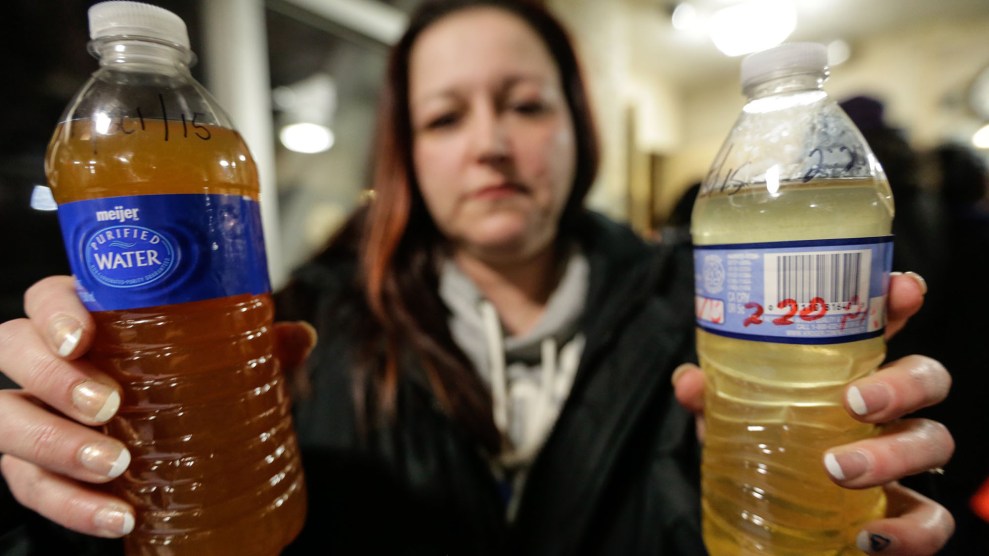
Genetha Campbell picks up water from a Flint church. Paul Sancya/AP
This story first appeared on the TomDispatch website.
“I know if I was a parent up there, I would be beside myself if my kids’ health could be at risk,” said President Obama on a recent trip to Michigan.
“Up there” was Flint, a rusting industrial city in the grip of a “water crisis” brought on by a government austerity scheme. To save a couple of million dollars, that city switched its source of water from Lake Huron to the Flint River, a long-time industrial dumping ground for the toxic industries that had once made their home along its banks. Now, the city is enveloped in a public health emergency, with elevated levels of lead in its water supply and in the blood of its children.
The price tag for replacing the lead pipes that contaminated its drinking water, thanks to the corrosive toxins found in the Flint River, is now estimated at up to $1.5 billion. No one knows where that money will come from or when it will arrive. In the meantime, the cost to the children of Flint has been and will be incalculable. As little as a few specks of lead in the water children drink or in flakes of paint that come off the walls of old houses and are ingested can change the course of a life. The amount of lead dust that covers a thumbnail is enough to send a child into a coma or into convulsions leading to death. It takes less than a tenth of that amount to cause IQ loss, hearing loss, or behavioral problems like attention deficit hyperactivity disorder and dyslexia. The Centers for Disease Control (CDC), the government agency responsible for tracking and protecting the nation’s health, says simply, “No safe blood lead level in children has been identified.”
President Obama would have good reason to worry if his kids lived in Flint. But the city’s children are hardly the only ones threatened by this public health crisis. There’s a lead crisis for children in Baltimore, Maryland, Herculaneum, Missouri, Sebring, Ohio, and even the nation’s capital, Washington, DC, and that’s just to begin a list. State reports suggest, for instance, that “18 cities in Pennsylvania and 11 in New Jersey may have an even higher share of children with dangerously elevated levels of lead than does Flint.” Today, scientists agree that there is no safe level of lead for children and at least half of American children have some of this neurotoxin in their blood. The CDC is especially concerned about the more than 500,000 American children who have substantial amounts of lead in their bodies. Over the past century, an untold number have had their IQs reduced, their school performances limited, their behaviors altered, and their neurological development undermined. From coast to coast, from the Sun Belt to the Rust Belt, children have been and continue to be imperiled by a century of industrial production, commercial gluttony, and abandonment by the local, state, and federal governments that should have protected them. Unlike in Flint, the “crisis” seldom comes to public attention.
Two, Three… Many Flints
In Flint, the origins of the current crisis lay in the history of auto giant General Motors (GM) and its rise in the middle decades of the twentieth century to the status of the world’s largest corporation. GM’s Buick plant alone once occupied “an area almost a mile and a half long and half a mile wide,” according to the Chicago Tribune, and several Chevrolet and other GM plants literally covered the waterfront of “this automotive city.” Into the Flint River went the toxic wastes of factories large and small, which once supplied batteries, paints, solders, glass, fabrics, oils, lubricating fluids, and a multitude of other materials that made up the modern car. In these plants strung out along the banks of the Flint and Saginaw rivers and their detritus lay the origins of the present public health emergency.
The crisis that attracted President Obama’s attention is certainly horrifying, but the children of Flint have been poisoned in one way or another for at least 80 years. Three generations of those children living around Chevrolet Avenue in the old industrial heart of the city experienced an environment filled with heavy metal toxins that cause neurological conditions in them and cardiovascular problems in adults.
As Michael Moore documented in his film Roger and Me, GM abandoned Flint in a vain attempt to stave off financial disaster. Having sucked its people dry, the company ditched the city, leaving it to deal with a polluted hell without the means to do so. Like other industrial cities that have suffered this kind of abandonment, Flint’s population is majority African American and Latino, and has a disproportionate number of families living below the poverty line. Of its 100,000 residents, 65 percent are African American and Latino and 42 percent are mired in poverty.
The president should be worried about Flint’s children and local, state, and federal authorities need to fix the pipes, sewers, and water supply of the city. Technically, this is a feasible, if expensive, proposition. It’s already clear, however, that the political will is just not there even for this one community. Gina McCarthy, the Environmental Protection Agency’s administrator, has refused to provide Flint’s residents with even a prospective timetable for replacing their pipes and making their water safe. There is, however, a far graver problem that is even less easy to fix: the mix of racism and corporate greed that have put lead and other pollutants into millions of homes in the United States. The scores of endangered kids in Flint are just the tip of a vast, toxic iceberg. Even Baltimore, which first identified its lead poisoning epidemic in the 1930s, still faces a crisis, especially in largely African American communities, when it comes to the lead paint in its older housing stock.
Just this month, Maryland’s secretary of housing, community, and development, Kenneth C. Holt, dismissed the never-ending lead crisis in Baltimore by callously suggesting that it might all be a shuck. A mother, he said, might fake such poisoning by putting “a lead fishing weight in her child’s mouth [and] then take the child in for testing.” Such a tactic, he indicated, without any kind of proof, was aimed at making landlords “liable for providing the child with [better] housing.” Unfortunately, the attitudes of Holt and Governor Rick Snyder of Michigan have proven all too typical of the ways in which America’s civic and state leaders have tended to ignore, dismiss, or simply deny the real suffering of children, especially those who are black and Latino, when it comes to lead and other toxic chemicals.
There is, in fact, a grim broader history of lead poisoning in America. It was probably the most widely dispersed environmental toxin that affected children in this country. In part, this was because, for decades during the middle of the twentieth century, it was marketed as an essential ingredient in industrial society, something without which none of us could get along comfortably. Those toxic pipes in Flint are hardly the only, or even the primary, source of danger to children left over from that era.
In the 1920s, tetraethyl lead was introduced as an additive for gasoline. It was lauded at the time as a “gift of God” by a representative of the Ethyl Corporation, a creation of GM, Standard Oil, and Dupont, the companies that invented, produced, and marketed the stuff. Despite warnings that this industrial toxin might pollute the planet, which it did, almost three-quarters of a century would pass before it was removed from gasoline in the United States. During that time, spewed out of the tailpipes of hundreds of millions of cars and trucks, it tainted the soil that children played in and was tracked onto floors that toddlers touched. Banned from use in the 1980s, it still lurks in the environment today.
Meanwhile, homes across the country were tainted by lead in quite a different way. Lead carbonate, a white powder, was mixed with linseed oil to create the paint that was used in the nation’s homes, hospitals, schools, and other buildings until 1978. Though its power to harm and even kill children who sucked on lead-painted windowsills, toys, cribs, and woodwork had long been known, it was only in that year that the federal government banned its use in household paints.
Hundreds of tons of the lead in paint that covered the walls of houses, apartment buildings, and workplaces across the United States remains in place almost four decades later, especially in poorer neighborhoods where millions of African American and Latino children currently live. Right now, most middle class white families feel relatively immune from the dangers of lead, although the gentrification of old neighborhoods and the renovation of old homes can still expose their children to dangerous levels of lead dust from the old paint on those walls. However, economically and politically vulnerable black and Hispanic children, many of whom inhabit dilapidated older housing, still suffer disproportionately from the devastating effects of the toxin. This is the meaning of institutional racism in action today. As with the water flowing into homes from the pipes of Flint’s water system, so the walls of its apartment complexes, not to mention those in poor neighborhoods of Detroit, Baltimore, Washington, and virtually every other older urban center in the country, continue to poison children exposed to lead-polluted dust, chips, soil, and air.
Over the course of the past century, tens of millions of children have been poisoned by lead and millions more remain in danger of it today. Add to this the risks these same children face from industrial toxins like mercury, asbestos, and polychlorinated biphenyls (better known as PCBs) and you have an ongoing recipe for a Flint-like disaster but on a national scale.
In truth, the United States has scores of “Flints” awaiting their moments. Think of them as ticking toxic time bombs — just an austerity scheme or some official’s poor decision away from a public health disaster. Given this, it’s remarkable, even in the wake of Flint, how little attention or publicity such threats receive. Not surprisingly, then, there seems to be virtually no political will to ensure that future generations of children will not suffer the same fate as those in Flint.
The Future of America’s Toxic Past
A series of decisions by state and local officials turned Flint’s chronic post-industrial crisis into a total public health disaster. If clueless, corrupt, or heartless government officials get all the blame for this (and blame they do deserve), the larger point will unfortunately be missed — that there are many post-industrial Flints, many other hidden tragedies affecting America’s children that await their moments in the news. Treat Flint as an anomaly and you condemn families nationwide to bear the damage to their children alone, abandoned by a society unwilling to invest in cleaning up a century of industrial pollution, or even to acknowledge the injustice involved.
Flint may be years away from a solution to its current crisis, but in a few cities elsewhere in the country there is at least a modicum of hope when it comes to developing ways to begin to address this country’s poisonous past. In California, for example, 10 cities and counties, including San Francisco, San Diego, Los Angeles, and Oakland, have successfully sued and won an initial judgment against three lead pigment manufacturers for $1.15 billion. That money will be invested in removing lead paint from the walls of homes in these cities. If this judgment is upheld on appeal, it would be an unprecedented and pathbreaking victory, since it would force a polluting industry to clean up the mess it created and from which it profited.
There have been other partial victories, too. In Herculaneum, Missouri, for instance, where half the children within a mile of the nation’s largest lead smelter suffered lead poisoning, jurors returned a $320 million verdict against Fluor Corporation, one of the world’s largest construction and engineering firms. That verdict is also on appeal, while the company has moved its smelter to Peru where whole new populations are undoubtedly being poisoned.
President Obama hit the nail on the head with his recent comments on Flint, but he also missed the larger point. There he was just a few dozen miles from that city’s damaged water system when he spoke in Detroit, another symbol of corporate abandonment with its own grim toxic legacy. Thousands of homes in the Motor City, the former capital of the auto industry, are still lead paint disaster areas. Perhaps it’s time to widen the canvas when it comes to the poisoning of America’s children and face the terrible human toll caused by “the American century.”
David Rosner and Gerald Markowitz, TomDispatch regulars, are co-authors and co-editors of seven books and 85 articles on a variety of industrial and occupational hazards, including Deceit and Denial: The Deadly Politics of Industrial Pollution and, most recently, Lead Wars: The Politics of Science and the Fate of America’s Children. Rosner is a professor of sociomedical sciences and history at Columbia University and co-director of the Center for the History of Public Health at Columbia’s Mailman School of Public Health. Markowitz is a professor of history at John Jay College and the Graduate Center, City University of New York. Both have been awarded a certificate of appreciation by the United States Senate through the office of Senator Sheldon Whitehouse, who has recognized the importance of their work on lead and industrial poisoning.













